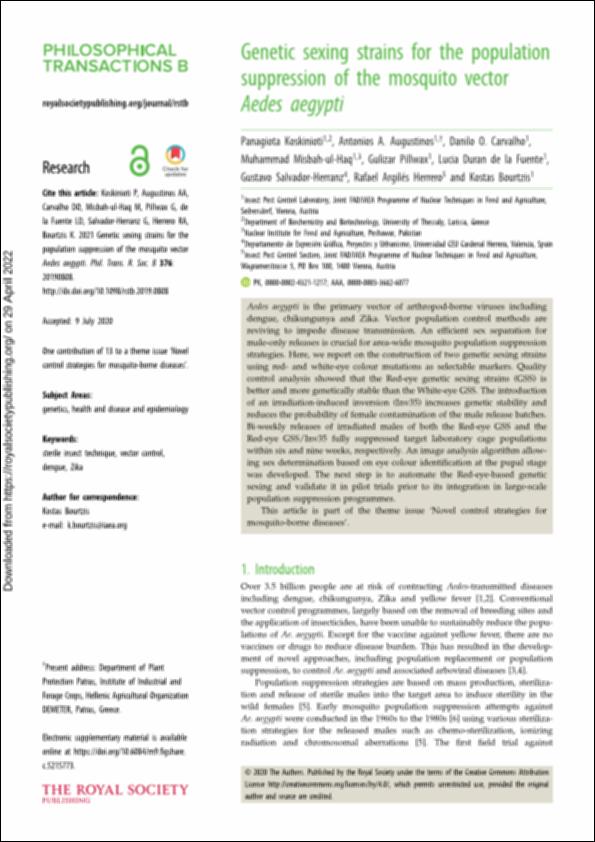Por favor, use este identificador para citar o enlazar este ítem:
http://hdl.handle.net/10637/13694Genetic sexing strains for the population suppression of the mosquito vector "Aedes aegypti"
| Título : | Genetic sexing strains for the population suppression of the mosquito vector "Aedes aegypti" |
| Autor : | Koskinioti, Panagiota Augustinos, Antonios A. Carvalho, Danilo O. Haq, Muhammad Misbah-ul Pillwax, Gulizar Durán de la Fuente, Lucía Salvador Herranz, Gustavo |
| Materias: | Mosquitoes - Genetics - Control.; Mosquitoes - Breeding.; Population genetics - Mathematical models.; Genética de poblaciones - Modelos matemáticos.; Culícidos - Genética - Control.; Animals as carriers of disease.; Animales vectores.; Culícidos - Cría y explotación.; Dengue.; Zika. |
| Editorial : | The Royal Society |
| Citación : | Koskinioti, P., Augustinos, A.A., Carvalho, D.O., Misbah-ul-Haq, M., Pillwax, G., Duran-de-la-Fuente, L., Salvador-Herranz, G., Argilés-Herrero, R. & Bourtzis, K. (2021). Genetic sexing strains for the population suppression of the mosquito vector "Aedes aegypti". Philosophical Transactions of the Royal Society B: Biological Sciences, vol. 376, i. 1818 (15 feb.), art. 20190808. DOI: http://doi.org/10.1098/rstb.2019.0808 |
| Resumen : | Aedes aegypti is the primary vector of arthropod-borne viruses including dengue, chikungunya and Zika. Vector population control methods are reviving to impede disease transmission. An efficient sex separation for male-only releases is crucial for area-wide mosquito population suppression strategies. Here, we report on the construction of two genetic sexing strains using red- and white-eye colour mutations as selectable markers. Quality control analysis showed that the Red-eye genetic sexing strains (GSS) is better and more genetically stable than the White-eye GSS. The introduction of an irradiation-induced inversion (Inv35) increases genetic stability and reduces the probability of female contamination of the male release batches. Bi-weekly releases of irradiated males of both the Red-eye GSS and the Red-eye GSS/Inv35 fully suppressed target laboratory cage populations within six and nine weeks, respectively. An image analysis algorithm allowing sex determination based on eye colour identification at the pupal stage was developed. The next step is to automate the Red-eye-based genetic sexing and validate it in pilot trials prior to its integration in large-scale population suppression programmes. |
| Descripción : | Este artículo se encuentra disponible en la página web de la revista en la siguiente URL: https://royalsocietypublishing.org/doi/epdf/10.1098/rstb.2019.0808 En este artículo también participan: Rafael Argilés Herrero y Kostas Bourtzis. Este artículo pertenece al número que lleva por título "Novel control strategies for mosquito-borne diseases". |
| URI : | http://hdl.handle.net/10637/13694 |
| Derechos: | http://creativecommons.org/licenses/by/4.0/deed.es |
| ISSN : | 0962-8436 1471-2970 (Electrónico) |
| Fecha de publicación : | 15-feb-2021 |
| Centro : | Universidad Cardenal Herrera-CEU |
| Aparece en las colecciones: | Dpto. Proyectos, Teoría y Técnica del Diseño y la Arquitectura |
Los ítems de DSpace están protegidos por copyright, con todos los derechos reservados, a menos que se indique lo contrario.


